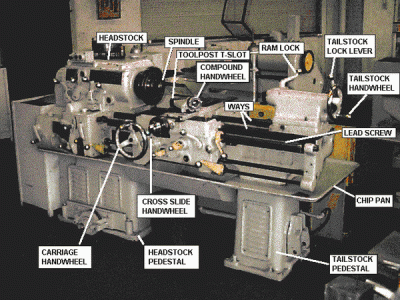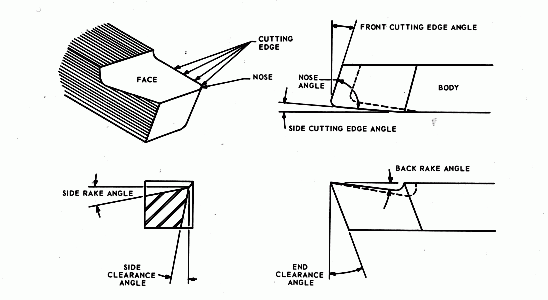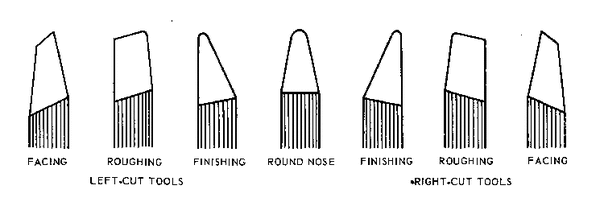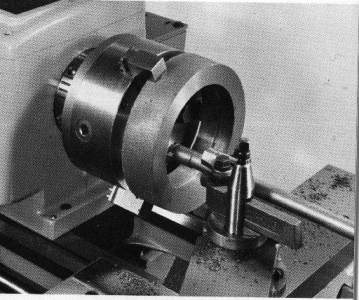- Joined
- Sep 22, 2010
- Messages
- 7,223

A Lathe in Building 35
Description
The purpose of a lathe is to rotate a part against a tool whose position it controls. It is useful for fabricating parts and/or features that have a circular cross section. The spindle is the part of the lathe that rotates. Various workholding attachments such as three jaw chucks, collets, and centers can be held in the spindle. The spindle is driven by an electric motor through a system of belt drives and/or gear trains. Spindle speed is contolled by varying the geometry of the drive train.
The tailstock can be used to support the end of the workpiece with a center, or to hold tools for drilling, reaming, threading, or cutting tapers. It can be adjusted in position along the ways to accomodate different length workpices. The ram can be fed along the axis of rotation with the tailstock handwheel.
The carriage controls and supports the cutting tool. It consists of:
- A saddle that mates with and slides along the ways.
- An apron that controls the feed mechanisms.
- A cross slide that controls transverse motion of the tool (toward or away from the operator).
- A tool compound that adjusts to permit angular tool movement.
- A toolpost T-slot that holds the toolpost.

Cutting Tool Terminology
The figure above shows a typical cutting tool and the terminology used to describe it. The actual geometry varies with the type of work to be done. The standard cutting tool shapes are shown below.
- Facing tools are ground to provide clearance with a center.
- Roughing tools have a small side relief angle to leave more material to support the cutting edge during deep cuts.
- Finishing tools have a more rounded nose to provide a finer finish. Round nose tools are for lighter turning. They have no back or side rake to permit cutting in either didection.
- Left hand cutting tools are designed to cut best when traveling from left to right.
- Aluminum is cut best by specially shaped cutting tools (not shown)that are used with the cutting edge slightly above center to reduce chatter.

Standard Cutting Tools
Installing a Cutting Tool
Lathe cutting tools are held by tool holders. To install a tool, first clean the holder then tighten the bolts.(2.11MB) (6.72MB)
The toolpost is secured to the compound with a T-bolt. The tool holder is secured to the tool post using a quick release lever.(1.99MB) (6.35MB)
Positioning the Tool
In order to move the cutting tool, the lathe saddle and cross slide can be moved by hand.(860kB) (2.91MB)
There are also power feeds for these axes. Procedures vary from machine to machine.
A third axis of motion is provided by the compound. The angle of the compound can be adjusted to allow tapers to be cut at any desired angle. First, loosen the bolts securing the compound to the saddle. Then rotate the compound to the desired angle referencing the dial indicator at the base of the compound. Retighten the bolts. Now the tool can be hand fed along the desired angle. No power feed is available for the compound. If a fine finish is required, use both hands to achieve a smoother feed rate. 2.05MB (6.54MB)
The cross slide and compound have a micrometer dial to allow accurate positioning, but the saddle doesn't. To position the saddle accurately, you may use a dial indicator mounted to the saddle. The dial indicator presses against a stop (often a micrometer as shown in the clip). 1.29MB (4.25MB)
Feed, Speed, and Depth of Cut
Cutting speed is defined as the speed at which the work moves with respect to the tool (usually measured in feet per minute). Feed rate is defined as the distance the tool travels during one revolution of the part. Cutting speed and feed determines the surface finish, power requirements, and material removal rate. The primary factor in choosing feed and speed is the material to be cut. However, one should also consider material of the tool, rigidity of the workpiece, size and condition of the lathe, and depth of cut. For most Aluminum alloys, on a roughing cut (.010 to .020 inches depth of cut) run at 600 fpm. On a finishing cut (.002 to .010 depth of cut) run at 1000 fpm. To calculate the proper spindle speed, divide the desired cutting speed by the circumference of the work. Experiment with feed rates to achieve the desired finish. In considering depth of cut, it's important to remember that for each thousandth depth of cut, the work diameter is reduced by two thousandths.
Turning
The lathe can be used to reduce the diameter of a part to a desired dimension. First, clamp the part securely in a lathe chuck (636kB). (2.91MB)
The part should not extend more that three times its diameter. Then install a roughing or finishing tool (whichever is appropriate). If you're feeding the saddle toward the headstock (as in the clip below) use a right-hand turning tool. Move the tool off the part by backing the carriage up with the carriage handwheel, then use the cross feed to set the desired depth of cut. In the clip below, a finish cut is made using the power feed for a smoother finish. Remember that for each thousandth depth of cut, the work diameter is reduced by two thousandths.
(click here for video) 821kB
Facing
A lathe can be used to create a smooth, flat, face very accurately perpendicular to the axis of a cylindrical part. First, clamp the part securely in a lathe chuck (636kB). Then, install a facing tool. Bring the tool approximately into position, but slightly off of the part. Always turn the spindle by hand (248kB)before turning it on. This ensures that no parts interfere with the rotation of the spindle. Move the tool outside the part and adjust the saddle to take the desired depth of cut. Then, feed the tool across the face with the cross slide. The following clip shows a roughing cut being made; about 50 thousandths are being removed in one pass. (click here for video) 2.35MB If a finer finish is required, take just a few thousandths on the final cut and use the power feed. Be careful clearing the ribbon-like chips; They are very sharp. Do not clear the chips while the spindle is turning. After facing, there is a very sharp edge on the part. Break the edge (205kB) with a file.
Parting
A parting tool is deeper and narrower than a turning tool. It is designed for making narrow grooves and for cutting off parts. When a parting tool is installed, ensure that it hangs over the tool holder enough that the the holder will clear the workpiece (but no more than that). Ensure that the parting tool is perpendicular to the axis of rotation and that the tip is the same height as the center of the part. A good way to do this is to hold the tool against the face of the part. Set the height of the tool, lay it flat against the face of the part, then lock the tool in place. (click here for video) 2.45MB When the cut is deep, the side of the part can rub against sides of the groove, so it's especially important to apply cutting fluid. In this clip, a part is cut off from a piece of stock.
(click here for video) 246kB
Drilling
A lathe can also be used to drill holes accurately concentric with the centerline of a cylindrical part. First, install a drill chuck into the tail stock. Make certain that the tang on the back of the drill chuck seats properly in the tail stock. Withdraw the jaws of the chuck and tap the chuck in place with a soft hammer. (click here for video) 1.93MB
Move the saddle forward to make room for the tailstock. Move the tailstock into position, and lock the it in place (otherwise it will slide backward as you try to drill). Before starting the machine, turn the spindle by hand. You've just moved the saddle forward, so it could interfere with the rotation of the lathe chuck. Always use a centerdrill to start the hole (2.30MB). You should use cutting fluid with the centerdrill. It has shallow flutes (for added stiffness) and doesn't cut as easily as a drill bit. Always drill past the beginning of the taper to create a funnel to guide the bit in (click for computer generated animation of funnel effect, not yet available). In this clip, a hole is drilled with a drill bit.(click here for video) 1.07MB Take at most one or two drill diameters of material before backing off, clearing the chips, and applying cutting fluid. If the drill bit squeeks, aplly solvent more often. The drill chuck can be removed from the tail stock by drawing back the drill chuck as far as it will easily go, then about a quarter turn more. A pin will press the chuck out of the collet. (click here for video) 554kB
Boring
Boring is an operation in which a hole is enlarged with a single point cutting tool. A boring bar is used to support the cutting tool as it extends into the hole. Because of the extension of the boring bar, the tool is supported less rigidly and is more likely to chatter. This can be corrected by using slower spindle speeds or by grinding a smaller radius on the nose of the tool.

Boring On a Lathe
Single Point Thread Turning
External threads can be cut with a die and internal threads can be cut with a tap. But for some diameters, no die or tap is available. In these cases, threads can be cut on a lathe. A special cutting tool should be used, typically witha 60 degree nose angle. To form threads with a specified number of threads per inch, the spindle is mechanically coupled to the carriage lead screw. Procedures vary for different machines.
Advanced Work Holding
Some parts require special techniques to hold them properly for lathe work. For instance, if you wish to cut on the entire outside diameter of a part, then the part cannot be held in a chuck or collet. If the part has a hole through it, you can press it on to a lathe arbor (a slightly tapered shaft), and clamp onto the arbor rather than the part itself. The hole must have an adequate aspect ratio or the part will not be firmly supported.
(click here for video) 554kB
If the part has a very large hole through it, a lathe arbor may not be a practicable solution. You may instead use the outside of the jaws to hold the inside diameter of the part.
(click here for video) 983kB
If the part has a very complex geometry, it may be neccesary to install the part onto a face plate. The face plate is then attached to the spindle.
(click here for video) 452kB

